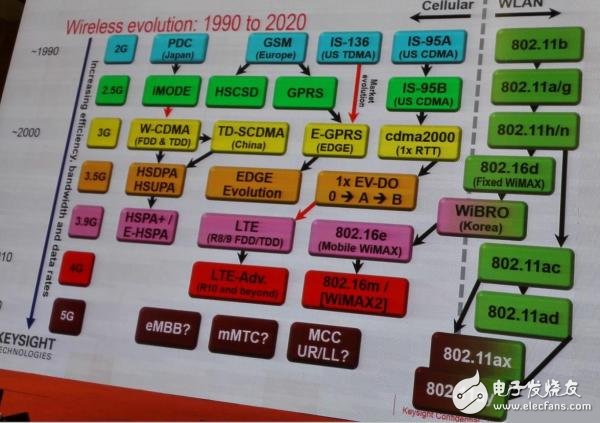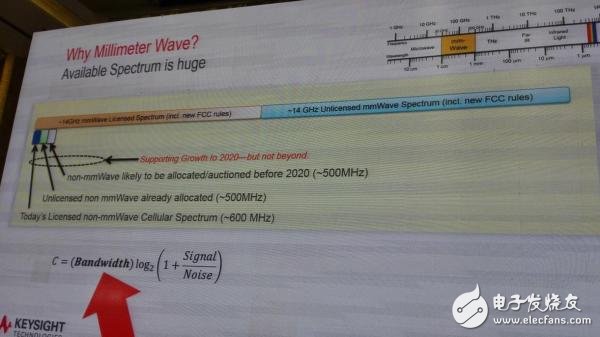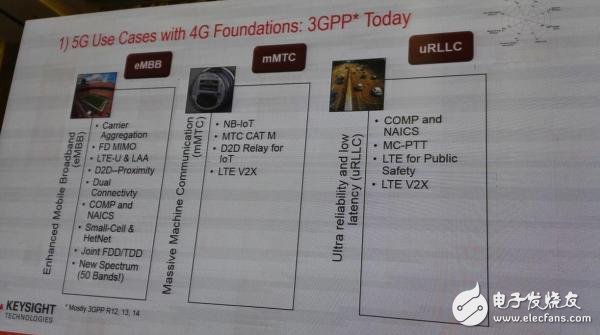Mobile communications and WLAN are evolving towards 5G and 802.11ax/ay to meet the growing demand for massive data transmission. The new millimeter wave band in 5G, in addition to providing a large bandwidth to increase the channel capacity, the device size can also be made small, and can use a large-scale antenna array-massive MIMO technology. Most of the current 5G Massive MIMO provides a minimum of 64 antenna elements, and no longer provides a test interface, so it cannot be tested by wire bonding, but must pass the air interface (OTA) test.
Recently, the Keysight Test and Measurement Conference (KMF 2017) was held in Shenzhen. The conference explored the latest trends in the wireless market and key technologies. At the same time, the company also brought two new products designed to meet the rigorous testing challenges of millimeter wave technology.
First look at the two main lines of wireless communication development. The left and right sides of the figure below are the development history of cellular communication and WLAN. Bai Wei, manager of wireless marketing department of Keysight China, said that the evolution of 5G and 802.11ay is logical, and the purpose is to transmit massive data.

From the perspective of cellular communications, the driving force comes from the need for a significant increase in the data rate of mobile terminals and an increase in the number of connections. At the same time, there will be more and more scenes for wireless applications. In the past, we liked to talk about how high the data rate is, such as mobile phone running points, but now, more importantly, there are applications that can't be uninstalled on mobile phones, such as WeChat and shared bicycles. These are directly linked to traffic and user experience.
Therefore, people have proposed a faster data rate (100 times faster), a larger capacity (everything interconnect, 1000 times more), higher density (100 times), 1ms delay, 99.999% reliability, 100 times energy efficiency for 5G. Overall demand.
However, according to Shannon's Law, to increase the channel capacity, it is necessary to increase the channel bandwidth, which is one of the reasons why the industry develops the millimeter wave band. In addition, in the millimeter wave era, the device volume can be made small, and a large-scale antenna array can be used. This is a very hot topic in current 5G research.

The V5G standard proposed by Verizon is ready to commercialize 5G networks at the center frequency of 28GHz. China is also studying frequency points such as 28 GHz, 39 GHz and even 45 GHz. Some leading base station manufacturers in the world have also begun to study the center frequency points of 60 GHz, 70 GHz and 90 GHz, in order to obtain a larger amount of bandwidth.
In addition to moving to higher, faster, and stronger directions, 5G is still moving toward lower latency and lower energy consumption. Most of the 5G cellular communications may be concentrated on eMBB (Enhanced Mobile Broadband) research, which uses a variety of technologies, such as large-scale antenna arrays, millimeter waves, and so on. Then there are IoT applications (including NB-IoT, CAT-M), which are classified as mMTC (Massive Machine Communication). The third category is uRLLC (Ultra High Reliability, Ultra Low Latency Communication), covering low latency applications such as automotive and telemedicine.

Small computer system interface (SCSI) is an independent processor standard for system level interfaces between computers and intelligent devices (hard disks, floppy drives, optical drives, printers, scanners, etc.). SCSI is an intelligent universal interface standard.
The last SCSI device in the SCSI chain uses a terminator, and the intermediate device does not need a terminator. Once the terminator is used by the intermediate device, the SCSI card cannot find the future SCSI device. If the last device does not use a terminator, SCSI will not work properly. Terminator is composed of resistors, located at the end of the SCSI bus, to reduce the mutual influence of the signal, maintain the constant voltage on the SCSI chain.
Most of the SCSI devices have built-in terminators and use a jumper to control on / off. The SCSI device is highly intelligent and can automatically control the terminator on / off. For example, if a hard disk is connected to a CD-ROM, the CD-ROM can work normally regardless of whether the terminator of the hard disk is on or off. However, when two hard disks are connected, the situation becomes more complicated. Before two Seagate hard disks are connected, one hard disk terminator must be off. Before a Seagate hard disk is connected to a quantum hard disk, a hard disk terminator can work normally regardless of whether it is on or off.
SCSI-90°DIP Section
ShenZhen Antenk Electronics Co,Ltd , https://www.antenkcon.com